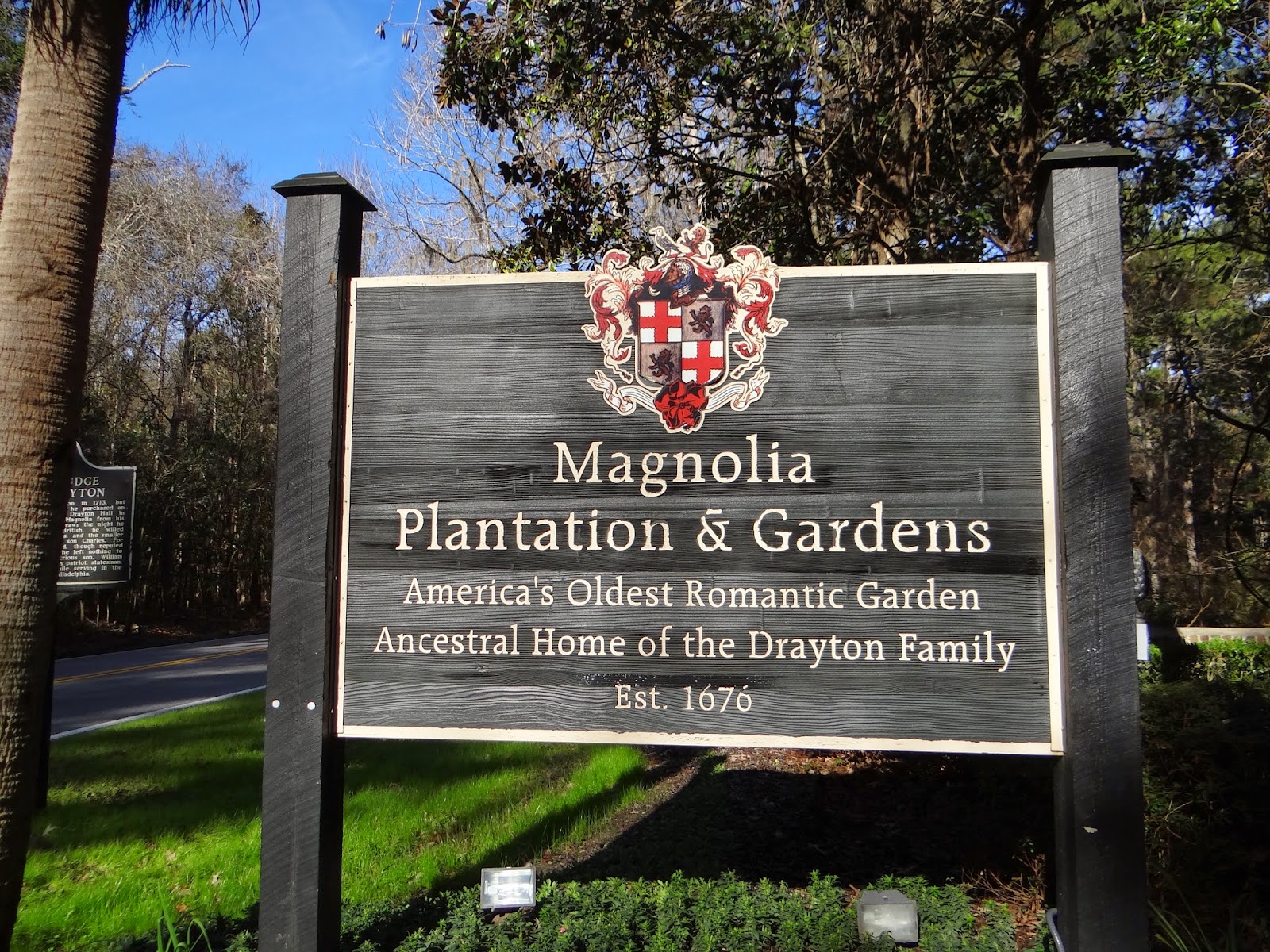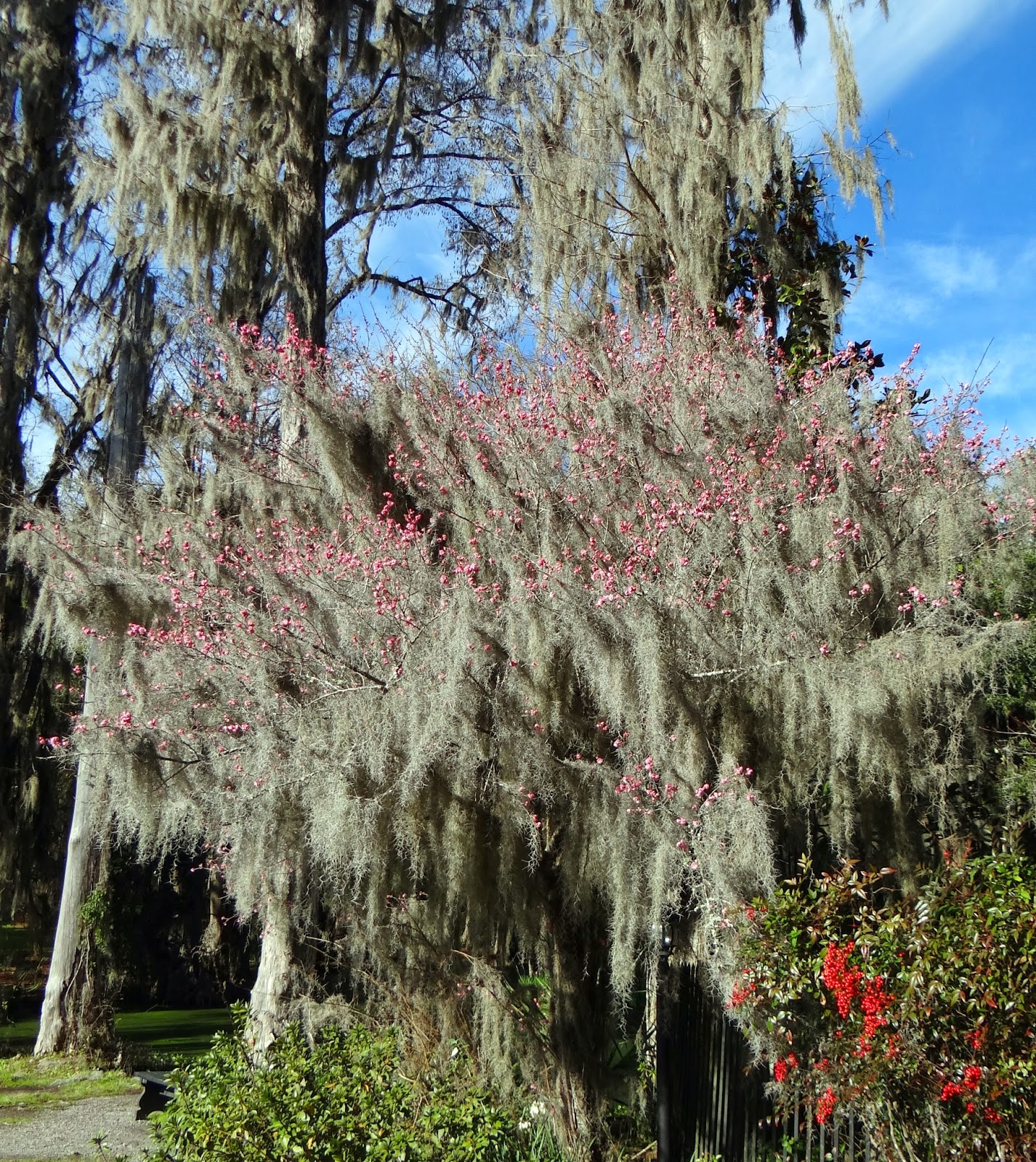Our next stop, the Magnolia Plantation, was once a rice plantation and known for its magnificent gardens.
While we were waiting for the house tour to begin, we did a little wandering. This schoolhouse was used to teach the children of plantation slaves, which was against the laws at the time.
A good book called "The Invention of Wings" by Sue Monk Kidd was written about the Grimke sisters and their work to establish women's rights and abolish slavery.
The plantation is still known for its beautiful gardens.
Isn't nature astounding? I believe this is a flowering crab, but the tree is practically obliterated by the Spanish moss--and yet it still blooms. Amazing!
The Drayton family home, built in 1873, is the third to stand on this site since the plantation was started in the 1600s. The first two houses burned. After the second fire during the Civil War, John Drayton opened the gardens to the public to raise money. It was seen by Charleston society as uncouth.
The view from the verandah...they do their best to live with nature.
The driveway originally led up to the centre of the house, but the third house was built beside the previous ones resulting in an offset driveway.
The lovely wide verandah...
Sadly, we weren't able to take photos inside the house. After the tour, it was off to explore the amazing gardens. I've circled the plantation house and you can see the huge expanse of the gardens.
The paths are well maintained and make for easy walking. They are lined with azaleas which must be beautiful when they are in bloom.
There are many, many statues on the grounds...
Some are nicely hidden amongst the vegetation...
One of several lakes...
The moss covered bricks make a perfect path liner...
Miss Juliana was the plantation boat that carried produce to Charleston...
Everywhere you looked was breathtaking scenery...
A view of the house as we walked the path behind it...
Every so often you would pop out of the woods and find yourself on the bank of the tidal Ashley River.
The plantation is known for its many live oaks...
This vault has been the resting place for nearly all of Magnolia's owners and their families, about 20 in all.
When they opened it recently, it was found that most of the coffins had disintegrated. The coffin on the right contains the very first owner. He was buried in 1715 in a welded lead coffin, which has withstood the test of time. The coffin on the left is from 1916 and, as the sign notes, is already in its final stages of deterioration.
A little further along the trail, a bench that Rev. Grimke Drayton used in planning his sermons for the week...
I'm not sure this can be the original bench, although it has definitely been there a while.
Another scene, another bridge...
And another...everywhere you turned was such beauty.
The vines are taking over...
Statue in the swamp...
What we thought to be pond scum, actually turned out to be duck weed, a high protein source for waterfowl.
We practically had the nature walk to ourselves. I think we only encountered one other couple that afternoon.
There are 60 acres of cedar and tupelo swamp on the grounds. At one time, the swamp served as a reservoir for the plantation's rice cultivation. Today you can enjoy the foliage and wildlife including turtles and alligators.
The signs were very helpful, as we learned that the knobs sticking out of the swamp are called cypress knees and are roots which rise above the water to get oxygen.
Next stop, the observation tower...
Jim took one look at that and said "Enjoy."
He actually did climb about halfway up before he met me coming down...
The view from the top included the historic rice fields...
The camellias were starting to bloom....
I think we might have already seen this bridge from another angle, but I couldn't resist taking yet another photo.
Cypress knees...
This statue was cleverly integrated into its surroundings...
A bench for contemplation...
Interesting burr on the tree...
Ooh...a different bridge...
Stunning...
The one couple we encountered kindly took our photo...
I know...about now every photo looks the same, but at the time, it was so hard to pass up any scene.
The original garden...
Meant to resemble an English garden, it must be wonderful when in bloom.
Another neat bench wedged between two trees...
The plantation is a popular venue for weddings...
Plentiful duck weed provided a green backdrop...
Jim and Kim on a lovely day...
On the way to the car, we came across the petting zoo. I wasn't sure how this went with their thoughts of living with nature and not controlling it, but I popped in anyway.
A snoozing goat...
I really was feeling sorry for this deer. Maybe it was rescued...
This peacock put on quite a show...
Shake your tail feathers!
Trying to outshine the roosters...
He appeared satisfied with his efforts...
Look how colourful the male is next to the female. It appears that a standoff is in order...
Sleeping piggies...
And with that it was time to go. On the way out I spied one of the slave cabins. We weren't supposed to be there as we hadn't paid for that part of the tour. I'm such a rule follower, so I scurried as fast as I could to snap a photo.
These cabins were actually "duplexes" with families of 6 or more occupying each side. Hard to imagine...
A line of cabins...most were built around 1850 and remained in use by freedmen after the Emancipation.
The ducks were loving the duck weed...
That was an amazing visit. You could easily spend a whole day there. As usual, we had somewhere else to be and that place was Savannah! Next stop, our home for the next two months.

























































































No comments:
Post a Comment